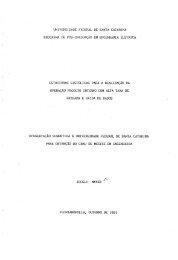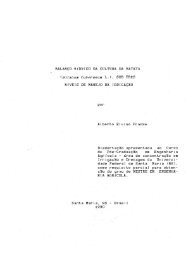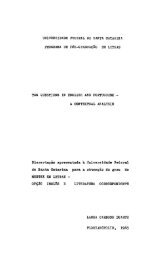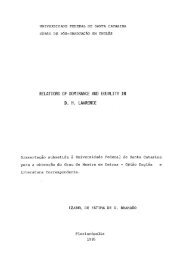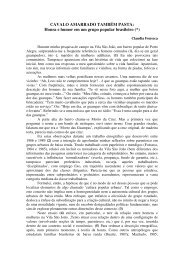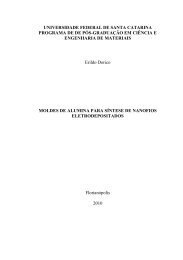nara lins meira quintão análise dos mecanismos envolvidos na ...
nara lins meira quintão análise dos mecanismos envolvidos na ...
nara lins meira quintão análise dos mecanismos envolvidos na ...
You also want an ePaper? Increase the reach of your titles
YUMPU automatically turns print PDFs into web optimized ePapers that Google loves.
ABSTRACT<br />
Brachial plexus avulsion (BPA) in mice (Swiss, C57/BL6 and J129) produced long-<br />
lasting mechanical and thermal sensitization, which were evaluated in the right hindpaw<br />
and in the tail. These altered sensations were not observed in the operated paw. The<br />
animals also did not show a sickness behaviour characterized by weight loss and<br />
decrease of locomotor activity. Data obtained with knockout TNFα p55 -/- mice, antibody<br />
anti-TNFα or thalidomide demonstrated that TNFα has a fundamental role in the onset<br />
of mechanical and thermal hypernociception. Furthermore, it was verified, by using<br />
antibodies against neurotrophic factors, that NGF, GDNF, BDNF and NT-3 have a role<br />
earlier in the process of mechanical hypernociception induced by BPA, probably in the<br />
sensitization of spi<strong>na</strong>l sensory neurones. On the other hand, only BDNF seemed to<br />
have importance for the mainte<strong>na</strong>nce of hypernociceptive responses in this model. B1<br />
kinin receptor, but not B2 kinin receptor, appeared to play a significant role in the<br />
genesis of hypernociceptive responses, confirmed by the use of knockout mice for each<br />
receptor (B1 or B2). Moreover, B1 receptor has an important participation on the<br />
mainte<strong>na</strong>nce of these sensory alterations using selective antagonists. We suggested<br />
here that the mediators cited above, and the B1 receptor seem to initiate a cascade of<br />
events responsible for the hypernociceptive state in this neuropathic pain model. On the<br />
other hand, the neurotrophic factor BDNF and B1 kinin receptor seem to be<br />
fundamentally related to the mainte<strong>na</strong>nce of mechanical hypernociception induced by<br />
BPA in mice. These results together, collaborate for better understand the mechanisms<br />
involved on the onset and on the mainte<strong>na</strong>nce of neuropathic pain.



